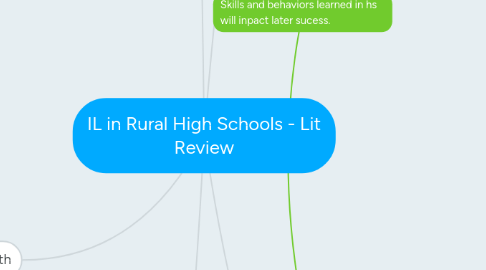
1. Info seeking re: health
1.1. Rural adults and health - seek information from trusted doctors, other health care providers and TV (Simmons) Internet trusted least
1.2. Even though Internet health info is not trusted, it is used by rural pop for health care info. 60% said it influenced their decisions.(Simmons)
1.3. Most women preferred anonymous sources rather than interpersonal ones (Simmons)
1.4. Lower income and education levels = less knowledge about how to seek health info (Simmons)
1.5. Reluctance to seek mental health info (Simmons)
1.6. Cultural mores of self-reliance in rural areas (Simmons)
2. Assessing IL skills
2.1. Strengths of a pre/post model
2.2. Limitations of pre/post model
2.3. iSkills assessment
2.4. Homegrown pre-/post with attitudinal questions and skills-based using the 1993 Barclay model (Carter)
2.5. Standardized tests not accurate. The skills themselves are hard to measure except as process (Fitzgerald)
2.6. Mix of quantitative pretest and qual follow-up (Dunn)
2.6.1. Pretest includes scenarios
2.7. IL lacks "clear variables that can be cleanly assessed." (Dunn)
2.8. ILT
2.8.1. Sample downloaded. Hard! I scored 80%.
2.9. Multiple choice tests not so great for assessing higher order skills (Walsh)
2.10. A lot of precedence for the multiple choice test. 34% of the literature on IL assessment uses this method. (Walsh)
2.11. SAILS
3. Teaching IL to hs students
3.1. Best practices re: pedagogy
3.2. Strategies
3.2.1. IL increases when assessments are authentic and higher order skills are emphasized. Curricular tie-ins are necessary. Constructivist approach. (Fabbi)
3.2.2. A curricular initiative, not a technology or library initiative (Allen)
3.2.3. Teach with enduring understandings in mind (Donham, Wiggens & McTighe)
3.2.4. Focus on big ideas, not discrete, minute skills (Donham)
3.2.5. Partner with teacher-librarians (Oakleaf)
3.2.6. Student-centered goals. Infuse playfulness and creativity. (Crow) [Study of 5th graders]
3.2.7. Have students help design the activity (Crow)
3.2.8. collaboration between librarians and teachers (Donham)
3.2.9. Point-of-need (Donham)
3.2.10. Hands-on (Donham)
3.2.11. Make sure that students have access to encyclopedias and other reference material (Fitzgerald)
3.2.12. Foster curiosity and questioning (Fitzgerald)
3.3. Assumptions
3.3.1. IL is being taught throughout the school in a systematic way. Not true. (Herring)
3.4. Needs
3.4.1. Need for basic IL and critical thinking skills beyond those that are content specific. (Fitzgerald)
4. Info seeking behavior in rural hs
4.1. Most students see value in IL practice but rely on teacher-librarian prompts (Herring)
4.2. A small minority of students will be engaged in their learning irrespective of teaching methods (Herring)
4.3. Transfer of IL skills from one setting to another is unlikely, unless a culture of transfer already exists in the school (Herring)
4.4. Fostering motivation is key (Crow)
4.5. Internal and external motivations. Students tend to resent the task when there are only external motivations. (Crow)
4.5.1. Choice is important for fostering intrinsic motivation (Crow)
4.5.2. Filling a student's desire to be competent (Crow)
4.5.3. Being connected to and part of a community of learners (Crow)
4.6. Constructivism (Vygotsky)
4.7. Information is limitless, which makes research a challenge. (Head and Eisenberg)
4.8. Defining the inquiry and getting started with research is hard for college students (Head and Eisenberg)
4.9. Learning is collaborative at the college level (Head and Eisenberg)
4.10. Students learn (or don't learn) techniques for organizing research projects in high school (Head and Eisenberg)
4.11. Technology not effectively used to manage research tasks (Head and Eisenberg)
4.12. Professors believe that students enter college poorly prepared in key skills and dispositions related to technology and IL. 2/3 cannot adequately analyze information ("The California Study" see Fitzgerald)
4.13. There is very little hard data about students actual, measurable skills. No data. (Fitzgerald)
4.14. Poverty, ethnicity, and parents' educational attainment influenced high schoolers' IL skills (Lance and Rodney)
5. Skills that students need for success in hs, college, and beyond
5.1. Standards and frameworks
5.1.1. Standards for the 21st Century Learner (AASL)
5.1.2. ACRL Framework
5.1.3. Common Core
5.1.4. Partnership for 21st Century skills
5.2. "Information savvy, not tech savvy" (Allen)
5.3. Media literacy
5.4. ICT literacy
5.5. Use articles, books, websites, reference books, data, and statistics in first year of college (Oakleaf)
5.6. Disposition to use learned skills (Crow)
5.7. Focus on a topic, compose a thesis statement, support an argument, evaluate info, and integrate it all into a cohesive research paper (Donham)
5.8. Synthesize and analyze information not covered in class (Fitzgerald)
5.9. Students drop out at alarming rates, most of them during the first year (Fitzgerald)
5.10. Three studies about what students need to know entering college
5.10.1. The California Study - Academic Literacy: A Statement of Competencies Expected of Students Entering California's Public Colleges andUniversities
5.10.1.1. Faculty expectations re: skills, habits of mind,
5.10.2. Standards for Success Understanding University Success: A Report from Standards for Success
5.10.2.1. Analysis of student writing and research
5.10.3. The Dunn Study
5.10.3.1. Measures competence of incoming college Freshmen in California

